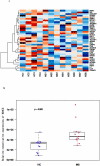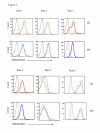Role of HDAC3 on p53 expression and apoptosis in T cells of patients with multiple sclerosis
- PMID: 21346816
- PMCID: PMC3035634
- DOI: 10.1371/journal.pone.0016795
Role of HDAC3 on p53 expression and apoptosis in T cells of patients with multiple sclerosis
Abstract
Background: Histone deacetylase 3 (HDAC3) belongs to a family of proteins which plays an important role in protein acetylation, chromatin remodeling and transcription of genes, including those that are involved in cell proliferation and cell death. While increased expression of HDAC3 is seen in neoplastic cells, the role of HDAC3 in T cells and their role in autoimmune disease is not known.
Methodology/principal findings: Applying Affymetrix GeneChip Human Gene 1.0 ST Array and the mixed effects model for gene set analysis, we compared gene expression profiles between multiple sclerosis (MS) patients and healthy controls (HC). Within the Apoptosis_GO gene set, the constitutive expression level of HDAC3 in peripheral blood mononuclear cell (PBMC) was significantly increased in MS patients when compared to controls. Following addition of trichostatin A (TSA), an inhibitor of HDAC3, we examined the expression of p53 by flow cytometry and p53 targeted genes by real time RT-PCR in MS and HC. Culture of PBMC with TSA resulted in increased expression of p53 in HC but not in MS patients. TSA treated T cells from MS patients also showed reduced sensitivity to apoptosis when compared to HC, which was independent of activation of p53 targeted pro-apoptotic genes.
Conclusion/significance: MS patients, when compared to controls, show an increased expression of HDAC3 and relative resistance to TSA induced apoptosis in T cells. Increased expression of HDAC3 in PBMC of MS patients may render putative autoreactive lymphocytes resistance to apoptosis and thereby contribute to autoimmunity.
Conflict of interest statement
Figures






References
-
- Compston A, Coles A. Multiple sclerosis. Lancet. 2008;372:1502–1517. - PubMed
-
- Frohman EM, Racke MK, Raine CS. Multiple sclerosis—the plaque and its pathogenesis. N Engl J Med. 2006;354:942–955. - PubMed
-
- Noseworthy JH, Lucchinetti C, Rodriguez M, Weinshenker BG. Multiple Sclerosis. NewEngJ Med. 2000;343:938–946. - PubMed
-
- Zivadinov R, Weinstock-Guttman B, Zorzon M, Uxa L, Serafin M, et al. Gene-environment interactions between HLA B7/A2, EBV antibodies are associated with MRI injury in multiple sclerosis. J Neuroimmunol. 2009;209:123–130. - PubMed
-
- McFarland HF, Martin R. Multiple sclerosis: a complicated picture of autoimmunity. Nat Immunol. 2007;8:913–919. - PubMed
Publication types
MeSH terms
Substances
LinkOut - more resources
Full Text Sources
Other Literature Sources
Medical
Molecular Biology Databases
Research Materials
Miscellaneous

